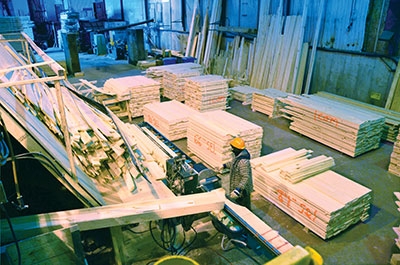
Features
Mills
Sawmilling
tree tenderloin
Sept. 2, 2014 - Outside the Coopérative Forestière de Girardville (CFG) Tradition mill behind the Administrative Office, huge trusses of 12x16s, 16 feet in length, are waiting to be delivered. A little farther away in the woods, the “tenderloin” of the forest, hundreds of large trees are lying on the ground before being debarked and sorted. Only the cream of the crop will go to the factory. The crooked or low-quality wood will be sent directly to the shredder to be made into biomass.
Upon entering the factory, I see huge, 12-inch planks of trembling aspen, 16 feet in length, propped up against the wall. A little further on, trimmer François Gagné sorts pieces based on their quality. Artistic pieces with interesting curves are preserved to bring maximum value to the wood. All this beautiful, seldom-seen wood is inspiring. Ideas for a thousand new projects spring to mind.
The entire structure for accommodating the equipment and treating the wood in the factory is made of wood. With the banks being risk-averse and financing difficult to obtain, “we have had to create this mill with the means we have,” says François Girard, mill co-owner together with the CFG. “Compared to a metal structure, the wooden structure decreases costs by 50 per cent.” Besides, the three-inch-thick wooden floor enormously reduces machinery vibration, which, despite the size of the equipment, is now almost imperceptible.
Valuing “annoyances”
“We would not want to compete with traditional mills, because they are also our clients who allow us to live by purchasing large volumes of wood,” explains Jérôme Simard, Director-General of the CFG. “For most of the sawmills, a log measuring over 17 inches in diameter is an annoyance.”
Creating value using the “annoyances” from other factories is the concept that gave birth to the CFG Tradition Mill. But the plant, which had belonged to the co-op from 1994 to 2000 and then to Bowater until 2003, lost its supply. Wood was needed in order to resuscitate the mill. And the opportunity came, thanks to the wood auctioning which has emerged with the new forest system launched in April 2013. “The new forest system was implemented precisely to promote innovative projects by manufacturing companies in order to increase value,” notes Luc Bouthillier, forest economist and professor of forest policy at Laval University.
Little wood, big value
The mill, which started operation in October 2013, should manufacture between 15,000 and 20,000 m3 of wood annually; this represents approximately 12,000 bd-ft. Five people operate the mill during a 10-hour work shift, while two employees deal with sorting and debarking in the yard. Next summer, the plant would like to add an evening shift to increase productivity.
The amount of wood processed is admittedly small, but the added value is more than interesting. “While the price of a 2x4 in Boston is around $420 / bd-ft, which is a good price, we can create up to $3,000 / bd-ft. And when sawing a 12x12, we produce many bd-ft at a time,” stresses Jérôme Simard. Depending on the products, the bd-ft value varies between $900 and $3,000.
In early March, the sawmill processes trembling aspen, “another annoyance,” which finds no takers in sawmills in Lac-Saint-Jean. The factory equipment is of a hybrid type. Based on orders, they can manufacture softwood or hardwood. “With the softwood, the grade is measured. This means that to make large beams, we are going to look at the quality of the wood around the heart. With hardwood, it’s the opposite. We aim to divide the heart to go for the best pieces towards the outside of the tree, because we find more nodes at the centre,” explains François Girard.
Thus, based on the orders, trembling aspen is transformed into boards and Jack Pine, black spruce and larch are transformed into large-dimension beams of up to 26-foot-long 12x16s! These beams are intended for the high-end construction market.
To manufacture these monsters, François Girard had to adapt equipment and train coop staff. “The equipment that we operate is made for large wood and requires custom expertise,” says the man who operated a Boisaco big-wood sawmill for four years before moving his equipment to north of Lac-Saint-Jean. Among other things, he has adapted his Hardy and Brothers trolley by 16 feet so it can take packages of up to 25 feet in length. It also uses a Cornell multi-saw edger and a Tronco surface edger. Also, by adding a 1,000-pound flywheel, he completely changed the transmission of a truck engine in order to use one motor instead of five.
At only 28 years old, François Girard, who made his mother “flip out” by purchasing his first saw at age 14, is already an expert in his field. The large-wood enthusiast has proven to be the quintessential successor on which the CFG is counting to innovate and develop new products. “We want to master sawing 100 per cent to ultimately develop structured articles of wood,” explains the young man, who also has a background in carpentry and joinery.
August 19, 2014 By Guillaume Roy Translated by Susanne Garmsen
 The mill Outside the Coopérative Forestière de Girardville (CFG) Tradition mill
The mill Outside the Coopérative Forestière de Girardville (CFG) Tradition millPrint this page